Arbitrum is no longer defined solely by Arbitrum One, but rather by the continuously expanding ecosystem of Arbitrum Chains driven by a feature-rich technology stack.
Author: Patryk Krasnicki
Compiled by: Deep Tide TechFlow
Abstract: In the vast ocean of blockchain, Arbitrum is ambitiously laying out its vision of a "Digital Sovereign Nation," driving DAO financial growth through high-profit block space and innovative revenue streams, weaving a technological, governance, and economic incentive network. Let us witness the sparks of this blockchain empire igniting.
Key Insights
The development of Arbitrum is guided by the vision of establishing a "Digital Sovereign Nation," pioneering a model in which decentralized governance on-chain entities leverage their resources to increase demand for their products and enhance their wealth.
Arbitrum offers dual products: Arbitrum One is one of the most active and liquid networks, with a stablecoin supply of $6.6 billion and a DeFi TVL of $2.59 billion; the other product, Arbitrum Orbit, consists of a diverse ecosystem made up of 48 custom Arbitrum Chains running on the mainnet.
This dual product strategy executes the "Arbitrum Everywhere" strategy, allowing developers to flexibly utilize shared liquidity on Arbitrum One or custom-create rollups with "Opinionated Blockspace" to meet the needs of various emerging use cases.
The economic engine of Arbitrum is driven by multiple on-chain revenue streams, including core protocol revenue and Timeboost auctions, the latter capturing MEV and generating over $1 million in revenue for the DAO within the first 44 days post-launch.
ArbitrumDAO leads the growth flywheel, funding ecosystem investment programs with deployed financial assets and supporting economic experimentation zones through initiatives like the Stable Financial Donation Program (STEP) and Arbitrum Gaming Ventures (AGV).
Today's Arbitrum
Arbitrum (ARB) is known for its Arbitrum One, a Layer-2 blockchain that has become one of the most active, liquid, and high-performing blockchains in the cryptocurrency space. However, this only covers part of the Arbitrum product suite, which has evolved into a comprehensive multi-product technology platform. Arbitrum's offerings consist of two distinct yet interconnected products serving different market segments.
Arbitrum One: The flagship L2 Rollup, providing a shared execution environment with capabilities equivalent to EVM. Its success is reflected in its on-chain GDP of $214.9 million year-to-date, a TVL of $2.59 billion, and a stablecoin supply of $6.6 billion, the highest among L2s as of May 31, 2025.
Arbitrum Orbit: The Arbitrum Nitro technology framework enables projects to deploy custom L2 or L3 networks using the same underlying infrastructure as Arbitrum One. These Arbitrum Chains can be customized for specific use cases while maintaining interoperability with the broader Arbitrum Orbit ecosystem.
This dual product strategy allows Arbitrum to extract value from shared infrastructure and custom deployment needs, addressing previously perceived competing market segments. Arbitrum One and Arbitrum Orbit together support the vision of "Arbitrum Everywhere," positioning Arbitrum as an infrastructure layer for widespread applications.
The "Arbitrum Everywhere" vision embodies a strategy that supports the entire application development lifecycle, from initial deployment on a shared liquidity layer to future migration to dedicated custom networks as demand evolves. This vision is led by three core pillars: performance, unity, and decentralization. The established goal is to advance all three pillars simultaneously rather than trade off between them.
Achieving this vision requires not only technological innovation but also a fundamental shift in project governance with the creation of ArbitrumDAO in March 2023. This marks Arbitrum's transformation from a project dominated by a single company, Offchain Labs, to a decentralized protocol governed collectively by ARB token holders. This move aims to empower the community and reflects Arbitrum's core belief: the story of Arbitrum is no longer limited to Ethereum's scaling but is about redefining the decentralized spirit inherent in the original crypto dream.
After initializing and deploying on-chain governance, Arbitrum is ready for expansion. Specifically, Arbitrum will become a shared rollup ecosystem built using Arbitrum Nitro and governed by ArbitrumDAO. Arbitrum Orbit launched in October 2023, and has now developed into 48 publicly announced Arbitrum Chains that have gone live on the mainnet, adding credibility to the name "Arbitrum Everywhere."
In 2025, Arbitrum will embark on a new phase of development, focusing on building a vibrant on-chain economy. The foundation for a "Digital Sovereign Nation" has been laid, and Arbitrum aims to set a precedent for how a decentralized protocol can achieve long-term economic prosperity.
Arbitrum One
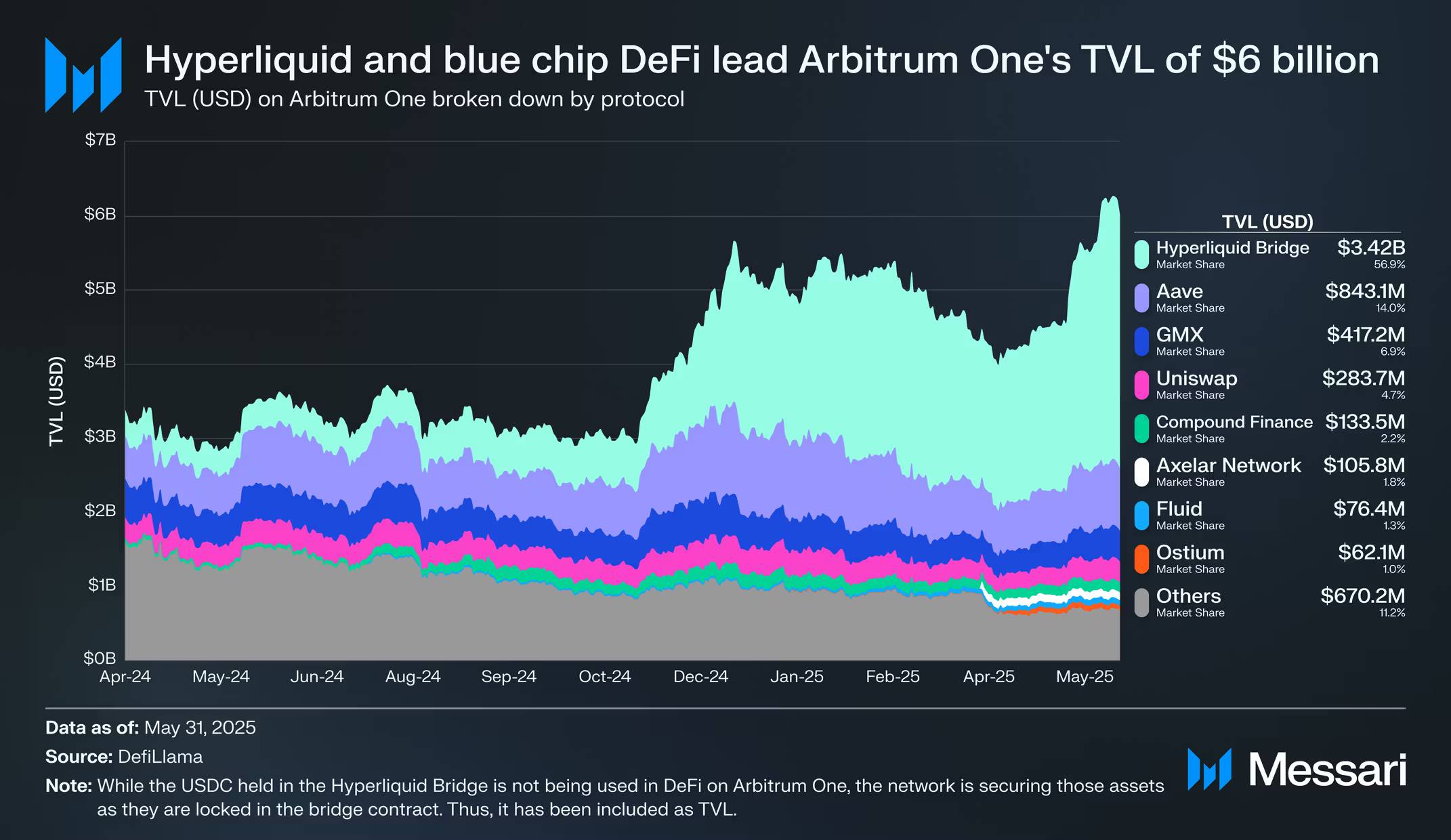
The expertise of Arbitrum One stems from its focus on DeFi. It is the most liquid DeFi platform within the Arbitrum Orbit ecosystem, with a Total Value Locked (TVL) of $2.59 billion as of May 31, 2025. However, if Hyperliquid and Hyperliquid Bridge are included, the total TVL of Arbitrum One would surge to $6 billion. All USDC liquidity from Hyperliquid Bridge comes from Arbitrum One, accounting for 56.9% of the total TVL, reaching $3.42 billion.
Arbitrum One also boasts the largest scale of L2 deployments for blue-chip DeFi protocols, such as Aave ($843.1 million), Uniswap ($283.7 million), Compound ($133.5 million), and Arbitrum-native GMX ($417.2 million). Additionally, Arbitrum includes several emerging protocols, such as:
Fluid: A lending protocol where deposited assets are also used to support its decentralized exchange (DEX). For a comprehensive overview of Fluid, see Messari's Initiation of Coverage report.
Ostium: A perpetual contract futures exchange focused on real-world assets (RWA). For an overview of the real-world perpetual contract market, including Ostium, see Messari's report on “Decentralizing Real-World Assets.”
Renegade: An on-chain dark pool that offers spot token trading while maintaining privacy and eliminating Maximum Extractable Value (MEV).
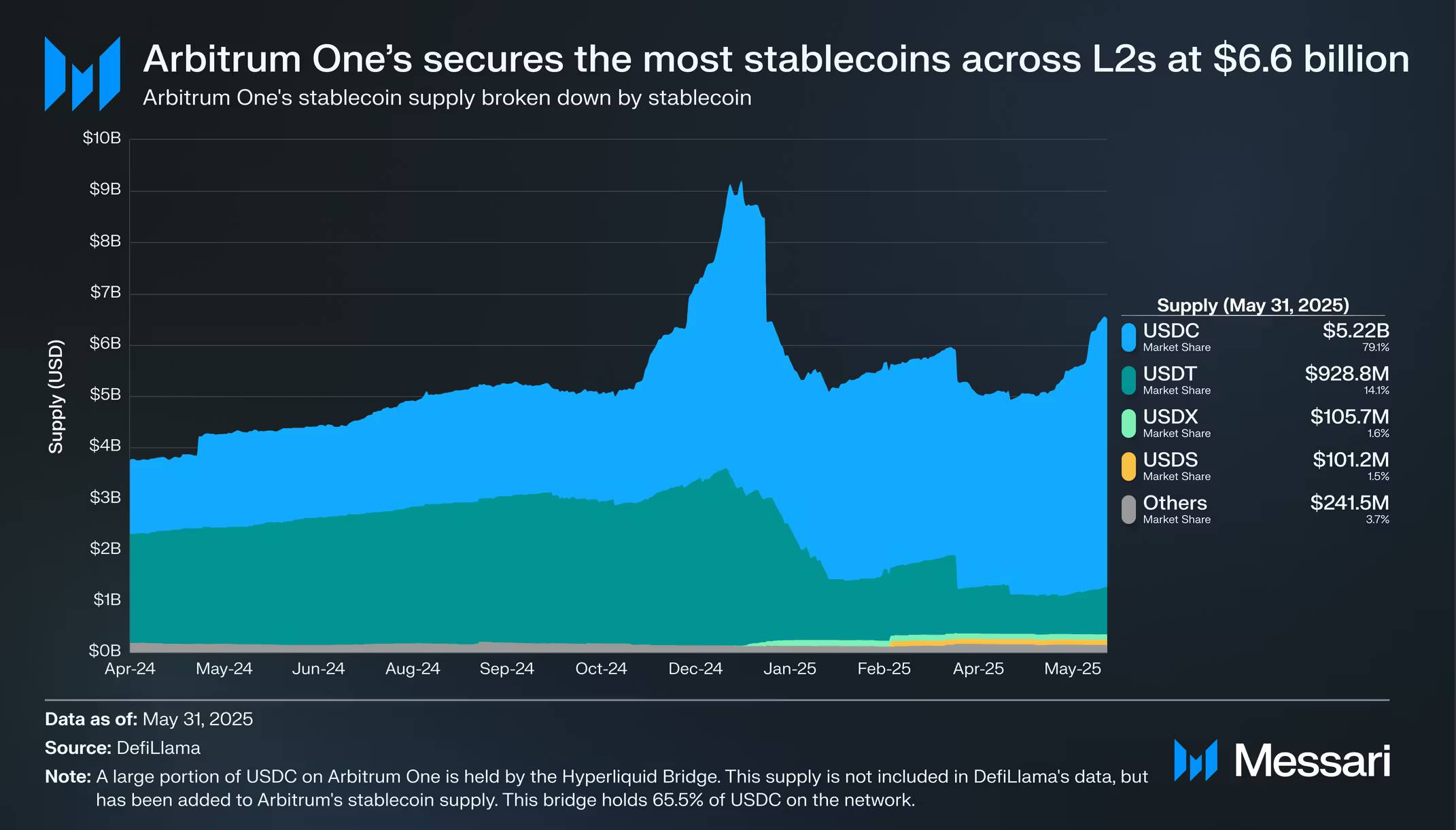
As of May 31, 2025, Arbitrum One's stablecoin supply is $600 million, the highest among all L2s. Hyperliquid Bridge holds 51.8% ($3.42 billion) of all stablecoins on Arbitrum One ($6.6 billion). This makes Circle the leading revenue-generating protocol on Arbitrum One this year, generating $62.1 million in revenue from the network's stablecoin supply. USDT is the second-largest stablecoin on Arbitrum One, accounting for 14.1% of all stablecoins, reaching $928.8 million. In January 2025, USDT0 launched as the full-chain implementation of USDT and uses Arbitrum One as its central liquidity hub.

The on-chain GDP of Arbitrum One, which represents the total revenue generated by applications on the network, reached $214.9 million from the beginning of 2025 to May 31, 2025. Uniswap, GMX, and Aave accounted for 40.5% of Arbitrum One's on-chain GDP.
The network's application revenue capture rate (App RCR) refers to the ratio of revenue generated by its applications to its real economic value (REV). In the case of Arbitrum One, REV is defined as the sum of base transaction fees, priority fees, and Timeboost auction revenue. As of May 31, 2025, the network's REV totaled $7.4 million, with an application RCR of 2,904% year-to-date. This can be understood as earning $2,904 in revenue for every $100 spent on fees and auctions on Arbitrum One.
If applications on the network successfully monetize activity and/or have lower transaction costs, the network's application revenue capture rate (App RCR) can exceed 1. For Arbitrum One, both conditions are met. Revenue streams from projects can even flow to project token holders. For example, the application revenue generated on GMX is partially shared with GMX stakers here.
Arbitrum Orbit
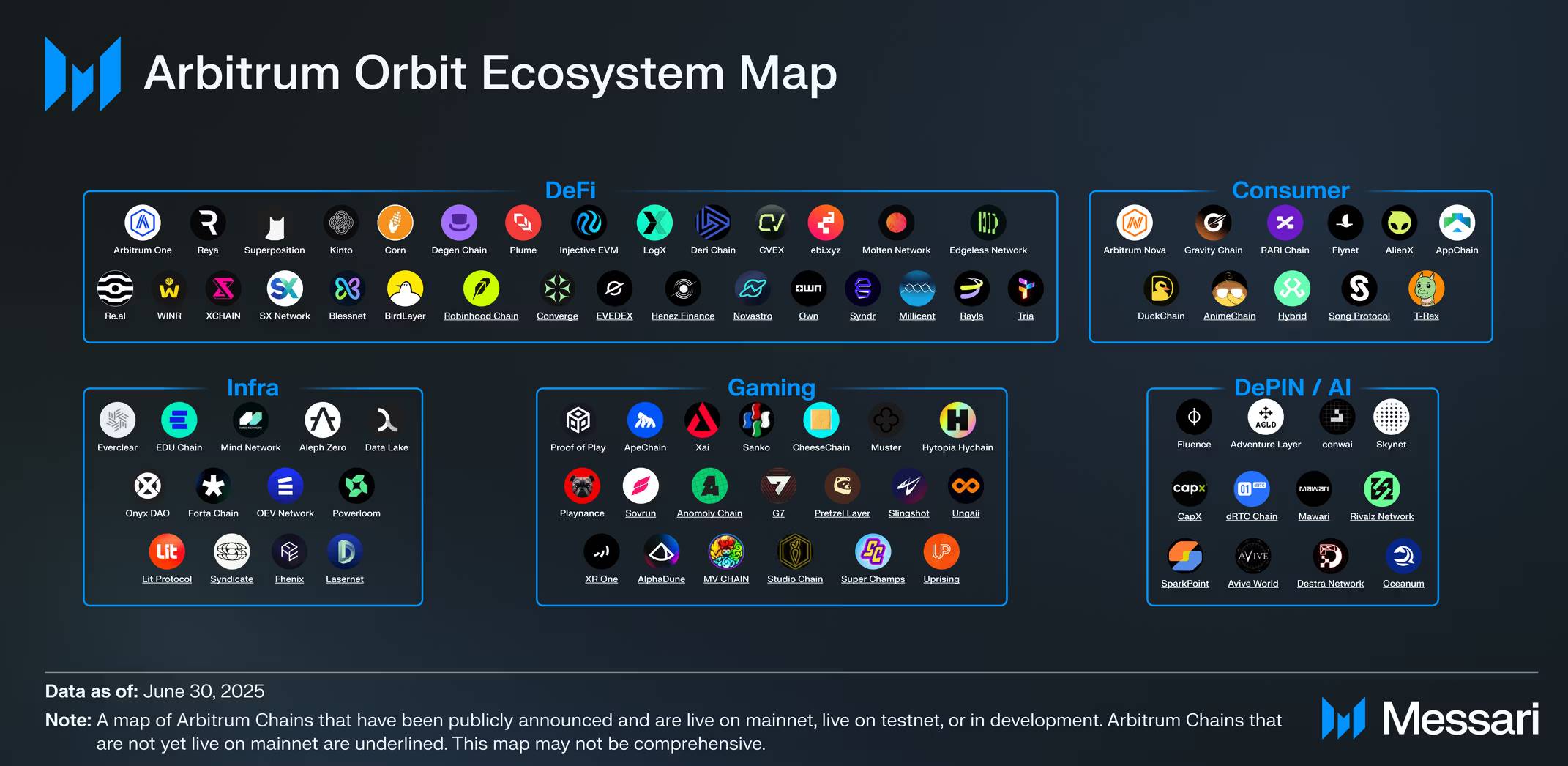
Arbitrum Orbit officially launched its mainnet in October 2023, meaning anyone can launch their own Arbitrum Chains. Rollup as a Service (RaaS) providers like Caldera, Gelato, Conduit, Alchemy, and AltLayer simplify the building process, supporting Arbitrum Chains such as ApeChain, Proof of Play, and ReyaChain.
The key driver of growth for Arbitrum Orbit lies in its technical flexibility. This tech stack allows developers to customize at the network level, creating dedicated block space for specific use cases. Customization features include:
Custom Gas Tokens: Arbitrum allows Arbitrum Chains to use any ERC-20 token (typically the project's own token) as payment for network transaction fees.
AnyTrust Protocol: Arbitrum's alternative data availability (DA) solution optimizes performance through off-chain actions by a trusted Data Availability Committee (DAC). Notably, Arbitrum Nitro also supports external DA providers like Celestia and EigenDA.
Layer-3s:: Arbitrum allows Arbitrum Chains to act as L3s, aggregating to L2s like Arbitrum One instead of L1s like Ethereum.
Arbitrum Chains can settle on L1s like Ethereum as L2s or settle on L2s like Arbitrum One as L3s here. As of May 31, 2025, the Arbitrum Orbit ecosystem includes 48 officially announced Arbitrum Chains that have launched on the mainnet, with an additional 38 in testing or development. Arbitrum Orbit has accumulated over 1.1 million weekly active addresses, a total locked value (TVL) of $13.7 billion, and a total transaction volume of 1.89 billion, accounting for 31.8% of all L2 transactions.
Arbitrum's Economic Engine
Digital Sovereign Nation
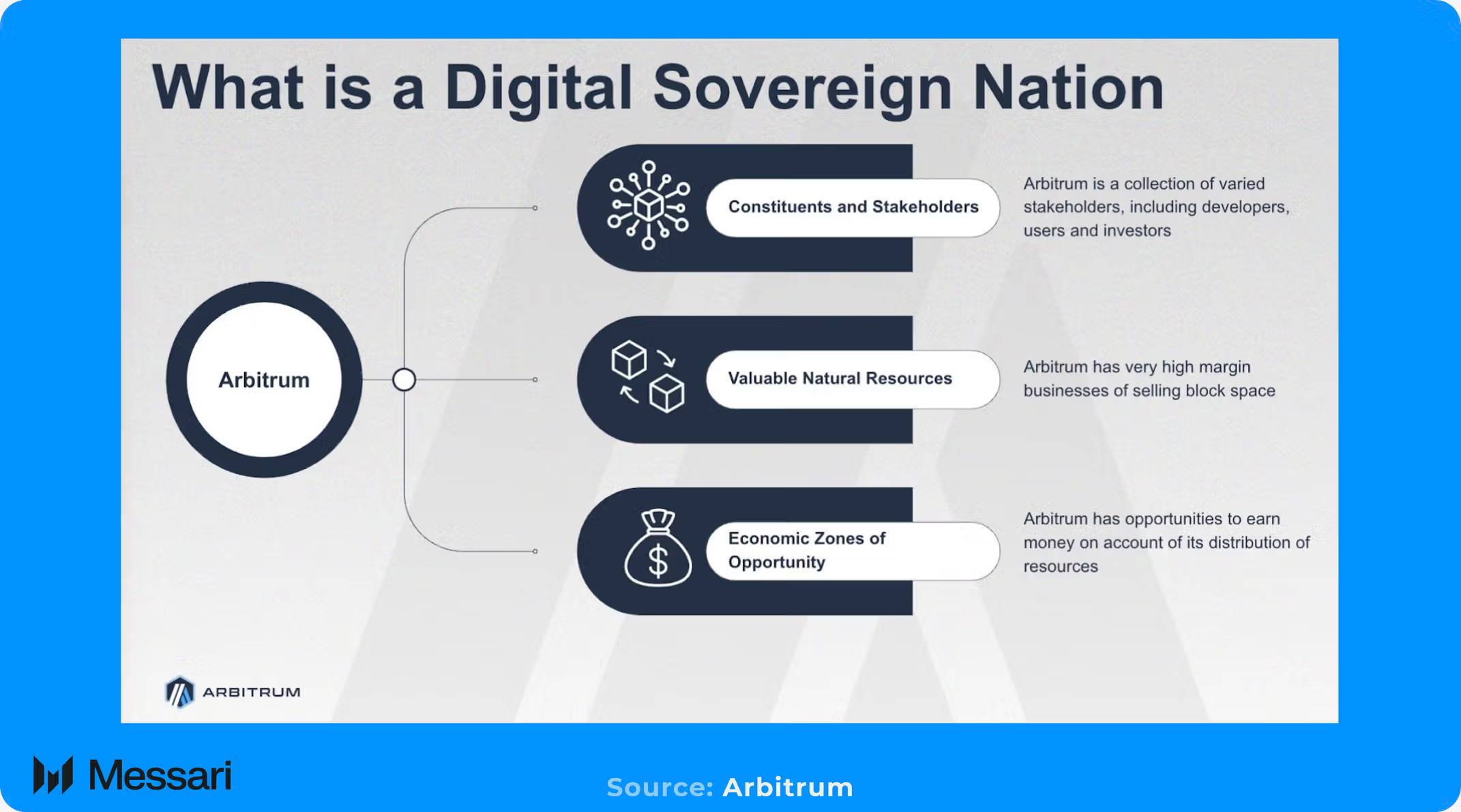
Arbitrum's next step in development stems from its vision of becoming a self-sufficient "Digital Sovereign Nation." The "Arbitrum Everywhere" strategy has birthed an economic and governance model that can be understood through three core elements: diverse participants and stakeholders, valuable digital assets, and economic experimentation zones generated by fiscal deployments.
Diverse Participants and Stakeholders: The first pillar consists of Arbitrum's participants and stakeholders, including developers, users, and investors, all represented by ArbitrumDAO. What makes Arbitrum's model unique is that it grants ArbitrumDAO full power, with complete on-chain control over protocol upgrades and fund holdings. This control is foundational to achieving the Digital Sovereign Nation.
Valuable Digital Assets: The second pillar is Arbitrum's valuable digital assets. Here, these assets refer to Arbitrum's block space and execution environment, which serve as high-margin digital commodities. The economics of Layer 2 allow it to retain a significant amount of network revenue, unlike Layer 1, which allocates most network revenue and issues new tokens to incentivize validators to maintain network security. The average gross margin for transactions on Arbitrum One exceeds 95%, and projects like Timeboost and the Arbitrum Expansion Program (AEP) also generate additional revenue, with the value generated from on-chain activities directly accumulating in the ArbitrumDAO treasury.
Economic Experimentation Zones Generated by Fiscal Deployments: The third pillar consists of economic experimentation zones that power the growth flywheel. The ability to create and retain revenue enables ArbitrumDAO to reinvest assets into new projects. These projects, in turn, drive demand for Arbitrum's block space and activities, further fueling growth and reinforcing the long-term vision of the Digital Sovereign Nation.
Growth Flywheel
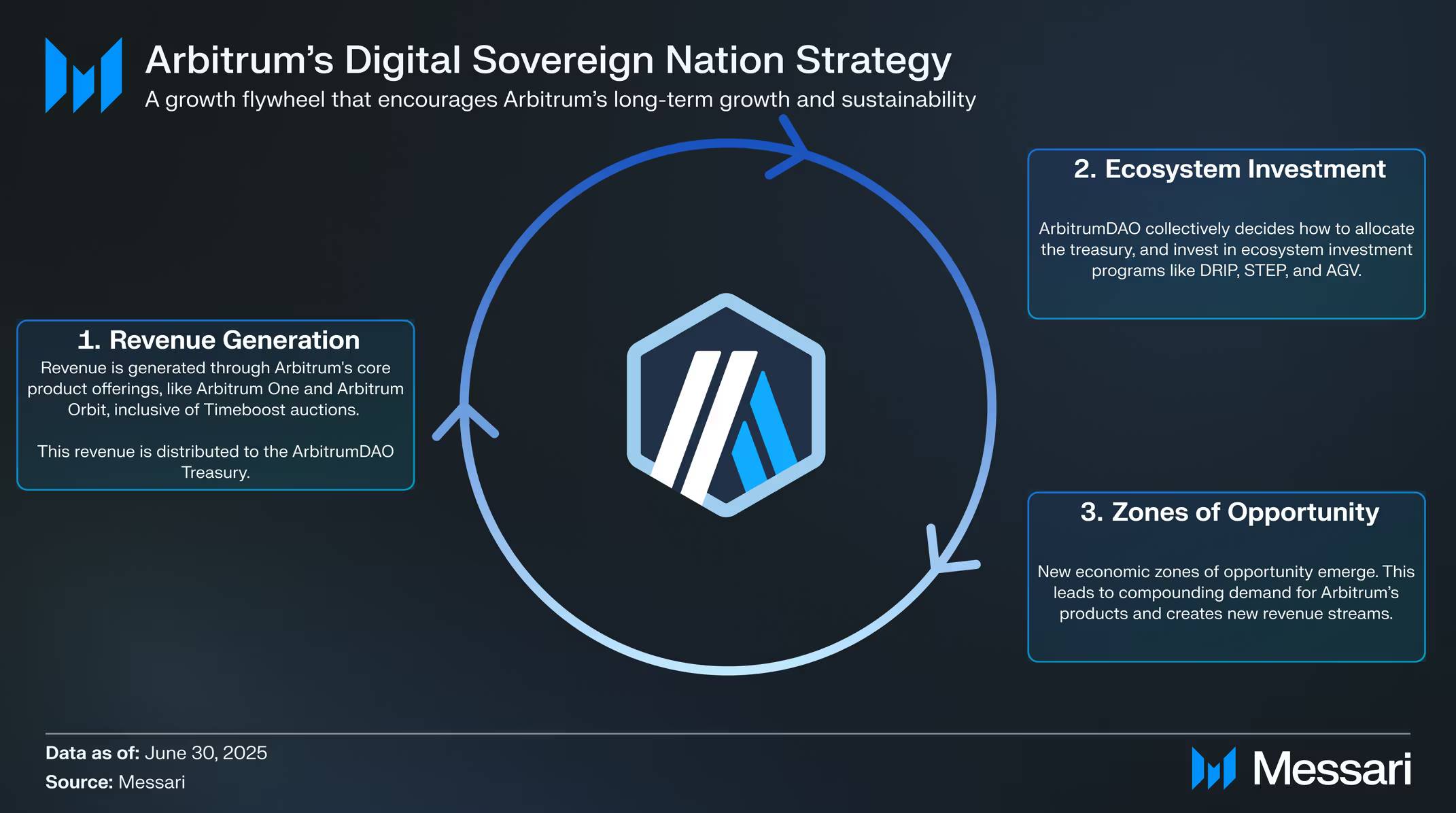
In the process of transitioning to a Digital Sovereign Nation, Arbitrum's core is a growth flywheel that returns value to its members and stakeholders. First, revenue comes from digital resources such as block space and execution environments. This revenue is allocated to a treasury fully managed by ArbitrumDAO. The DAO invests in ecosystem investment projects and economic experimentation zones, driving compound growth in product demand while expanding its asset base.
Core Protocol Revenue

ArbitrumDAO derives value directly from the usage of Arbitrum's core products, including Arbitrum One and Arbitrum Orbit. This model of accumulating value directly into a treasury controlled by the DAO is a key differentiator for Arbitrum. Arbitrum One and Arbitrum Nova contribute 100% of sequencer profits to ArbitrumDAO. All other Arbitrum Chains are required to share 10% of sequencer profits as part of the Arbitrum Expansion Program (AEP), with 8% going to ArbitrumDAO and 2% to the Arbitrum Developer Guild. Notably, L3s settling to Arbitrum Chains like Arbitrum One are exempt from profit sharing. From the beginning of the year until May 31, 2025, ArbitrumDAO has generated $7.5 million in revenue from these sources.
Timeboost
In March 2023, Offchain Labs announced the development of the Timeboost protocol, which modifies the transaction ordering of sequencers. This modification aims to preserve Arbitrum's consistent fair first-come, first-served model while creating new revenue streams for ArbitrumDAO through auctioning priority transactions. Timeboost introduces approximately 250 milliseconds of latency and a transaction express lane that can be auctioned, allowing for the extraction of maximum extractable value (MEV) from strategies like atomic arbitrage and liquidations.

Timeboost launched on April 17, 2025, initially on Arbitrum One and Arbitrum Nova. Just 44 days after launch, Timeboost's total revenue exceeded $1 million. As of May 31, 2025, Timeboost achieved an annualized revenue of $11.3 million as planned (based on a 30-day moving average). Of this, 97% of the revenue is allocated to ArbitrumDAO, with the remaining 3% going to the Arbitrum Developer Guild.
Timeboost auctions have consistently accounted for over 50% of the network REV (real economic value) generated by Arbitrum One, with over 99% of auctions having active bidders. Additionally, other Arbitrum Chains can choose to implement Timeboost as part of their Arbitrum Nitro integration. As Timeboost is adopted by other Arbitrum Chains, its significance may continue to grow.
Ecosystem Investment Program
Any applications built on Arbitrum One and all Arbitrum Chains are eligible for support from the Arbitrum Ecosystem Investment Program. Throughout the development of ArbitrumDAO, the Ecosystem Investment Program has continuously distributed ARB tokens to promote the long-term growth of Arbitrum and enhance market demand for the Arbitrum platform. This is also a crucial part of Arbitrum's vision of "Arbitrum Everywhere" and becoming a self-sufficient Digital Sovereign Nation.
DeFi Revival Incentive Program (DRIP)
The DeFi Renaissance Incentive Program (DRIP) was approved on June 23, 2025, aimed at incentivizing DeFi activities on Arbitrum One to achieve specific goals, such as becoming "the best platform for borrowing USDT, USDC, and ETH with wstETH as collateral." DRIP will launch up to four quarterly periods of 3 months each, with a maximum allocation of 20 million ARB per quarter (0.2% of the total token supply). Entropy Advisors, Arbitrum Foundation, and Offchain Labs will serve as the program's managers, with plans to launch in July 2025.
Onchain Labs
In March 2025, the Arbitrum Foundation and Offchain Labs established Onchain Labs, aimed at "accelerating innovative on-chain experiences on Arbitrum." The first project incubated by Onchain Labs, Talos, is set to launch in July 2025. Talos is an upcoming protocol controlled by an AI agent that autonomously manages financial assets, token economics, and protocol mechanisms. However, the agent will be governed by its future token holders, who will propose upgrades through GitHub after community voting.
Other Ecosystem Funding Programs
The Arbitrum Foundation and ArbitrumDAO also support funding programs. In the past, these programs have included the Trailblazer AI Grant Program, Stylus Sprint, Arbitrum x Farcaster Buildathon, Uniswap-Arbitrum Grant Program, Pluralistic Grants Program, and ArbiFuel.
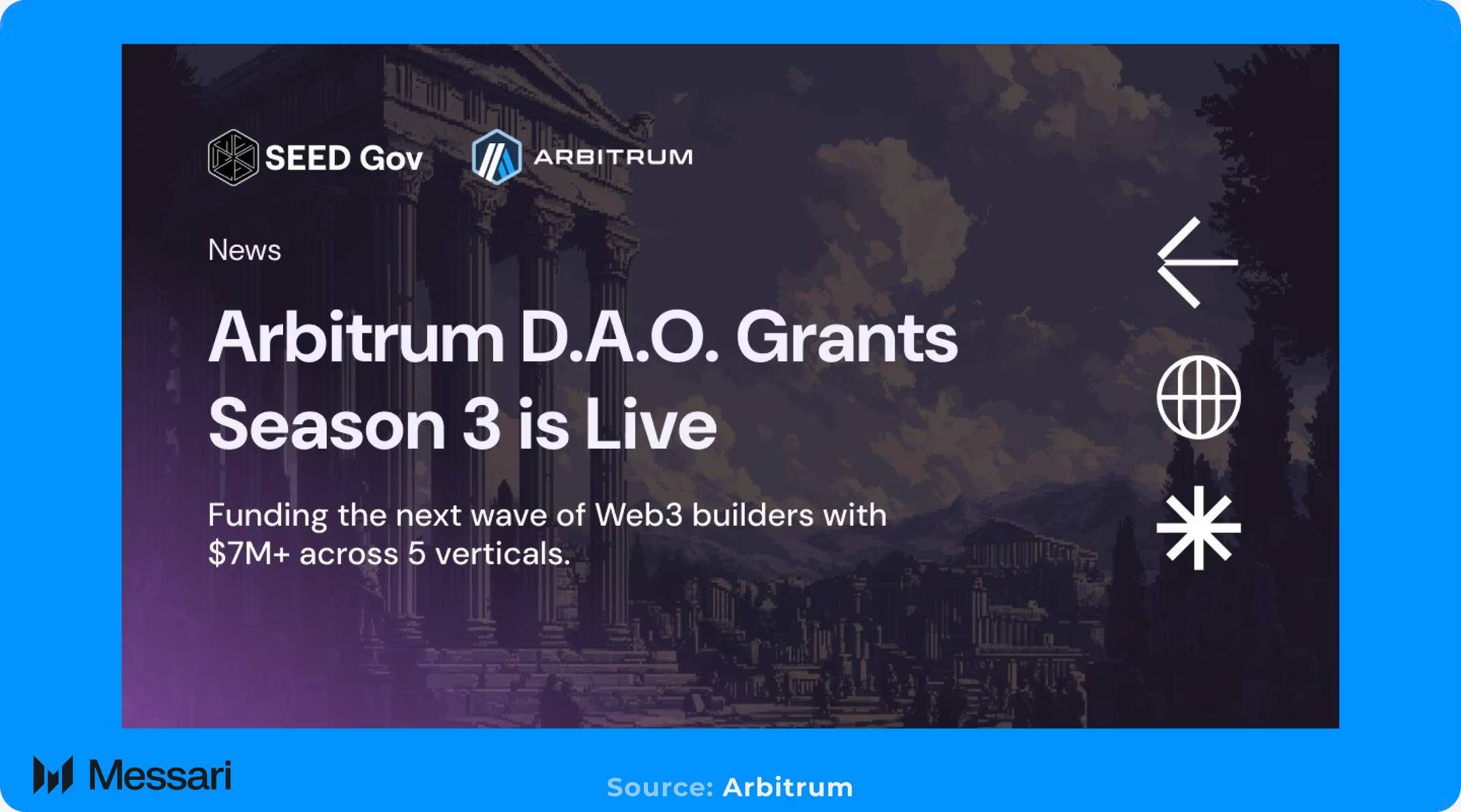
The Arbitrum DAO (Domain Allocator Product) reward program for Season 3 was approved in February 2025 and will run for two quarters starting from October 2023, continuing for a year until March 2026. It will distribute 23.4 million ARB (0.23% of the total token supply) to five categories of projects through Questbook.
Previously, ArbitrumDAO also approved several incentive programs that distribute ARB tokens within the Arbitrum Orbit ecosystem:
Short-Term Incentive Program (STIP): The STIP was approved in October 2023, allocating 50 million ARB (0.5% of the total token supply) to 30 Arbitrum Orbit projects as incentives to distribute to their users.
STIP Backfund: The STIP Backfund was approved in November 2023, allocating 21.5 million ARB (0.22% of the total token supply) to 26 Arbitrum Orbit projects that had received STIP approval but did not make it into the top 30 to receive funding.
STIP Bridge: The STIP Bridge was approved in May 2024, allocating an additional 37.5 million ARB (0.37% of the total token supply) to previous recipients of STIP or STIP Backfund.
Long-Term Incentive Program (LTIP): The LTIP was approved in February 2024, allocating up to 45 million ARB (0.45% of the total token supply) to projects that received STIP.
Economic Experiment Zone
As of May 31, 2025, the assets held by the ArbitrumDAO treasury were valued at $1.21 billion and continue to grow from core protocol revenues. ArbitrumDAO utilizes these assets to invest in economic sectors with opportunities, thereby generating new revenue streams. This proactive capital allocation strategy is a core component of the growth flywheel, enabling the DAO to continuously invest in the growth of Arbitrum.
Stable Treasury Donation Program (STEP)
In December 2023, a proposal was approved to establish a Finance and Sustainability Working Group to support the financial operations of ArbitrumDAO. In January 2024, kpk released the Arbitrum Finance and Sustainability Research Report, assessing the impact of potential ARB token sales, exploring potential uses of ETH-denominated sequencer revenue, and formulating effective financial management guidelines.

Efforts to diversify treasury holdings and generate returns began with the Stable Treasury Donation Program (STEP). This program aims to diversify part of the treasury holdings into stable real-world assets (RWA) that can generate returns and significantly increase the adoption rate of RWA on Arbitrum One.
Step 1: Proposed by the Finance and Sustainability Working Group, it was approved in April 2024. Step 1 converts 35 million ARB (0.35% of the total token supply) into RWA. A total of 33 applications were received, with 6 approved through off-chain voting on Snapshot approved. The sale of ARB generated $29.3 million, which was subsequently converted into Securitize's BUIDL ($9.6 million), Ondo's USDY ($5.2 million), Superstate's USTB ($5.2 million), Mountain's USDM ($3.5 million), OpenEden's TBILL ($3.5 million), and Backed Finance's bIB01 ($3.5 million).
Step 2: Proposed by the Finance and Sustainability Working Group and approved in February 2025, Step 2 will convert 35 million ARB (0.35% of the total token supply) into RWA, specifically WisdomTree's WTGXX, Spiko's USTBL, and Franklin Templeton's BENJI.
As of May 31, 2025, the ArbitrumDAO treasury's RWA holdings totaled $27.6 million. Since its inception, STEP has generated a total of $745,000 in interest income.
Arbitrum Gaming Ventures (AGV)
Arbitrum Gaming Ventures (AGV, formerly known as the Gaming Catalyst Program (GCP)) was approved in June 2024, allocating up to 200 million ARB (2% of the total token supply) for investments in Arbitrum Orbit game studios, applications, and chains. The goal of AGV is to "bring in excellent developers and help them accelerate development at various stages of the game lifecycle." The funding is divided into the following three categories:
Development Grants: 25 million ARB (0.25% of the total token supply) for "accelerating teams in early development on Arbitrum or incentivizing users to join."
Investments: 135 million ARB (1.35% of the total token supply) for "teams seeking additional development funding beyond 500,000 ARB or initial development."
Infrastructure Bounties: 40 million ARB (0.40% of the total token supply) for "creating game-specific technologies to make Arbitrum the best choice for game developers."
AGV also issued 25 million ARB (0.25% of the total token supply) for operations. AGV is an entity aligned with Arbitrum, led according to its charter and key performance indicators (KPI), and is overseen by a five-member CGP council.
The majority of ARB allocated to GCP is intended for venture capital investments, which will bring multiple returns to ArbitrumDAO. AGV announced its first investment of $10 million on May 8, 2025, targeting Wildcard, Hyve Labs, T-Rex, Xai, and Proof of Play. The latest update released by AGV on May 31, 2025, emphasized that over 70 projects are in preparation for investment. A complete list of investments by Arbitrum Gaming Ventures can be viewed on Messari Fundraising.
Arbitrum Technology
Arbitrum's technology stack supports the Arbitrum Chains that make up the Arbitrum Orbit ecosystem. The core of Arbitrum technology is Arbitrum Nitro, a technology stack developed by Offchain Labs. Arbitrum Nitro has evolved into a continuously developing technology stack capable of meeting the demands of various emerging use cases. A key principle of Arbitrum Nitro is focus on customizability and autonomous block space, allowing developers to customize at the network level according to their protocol's needs, thus supporting the vision of “Arbitrum Everywhere”.
Stylus

In February 2023, Offchain Labs announced the development of Stylus, an upgraded virtual machine that can run in parallel with the EVM. Stylus was launched in September 2024, initially operating on Arbitrum One and Arbitrum Nova. It allows developers to compile non-EVM programming languages such as Rust, C/C++, Zig, and Bf into WebAssembly (WASM), thus maintaining interoperability with the EVM. Therefore, smart contracts written in different languages can interact with each other (for example, a smart contract written in Solidity can call a smart contract written in Rust). Current protocols using Stylus include Renegade Finance, Superposition, Uniswap, and Fairblock.
Bounded Liquidity Delay (BoLD)
In August 2023, Offchain Labs announced the development of the Bounded Liquidity Delay (BoLD) protocol, which will introduce a permissionless anti-fraud system that allows a single honest validator to protect the rollup from malicious sequencer attacks. The dispute protocol of BoLD allows anyone to publish statements about the state of the Arbitrum Chain on its parent chain (for example, Ethereum for Layer 2 or Arbitrum One for Layer 3). If a challenge is successful, the bond submitted by the malicious party will be forfeited. For a deeper understanding of BoLD, Offchain Labs has written a protocol whitepaper, a technical whitepaper, and an economic whitepaper.
After ten months of testnet testing and receiving approval from ArbitrumDAO, BoLD officially launched in February 2025. Arbitrum's BoLD meets one of the five necessary conditions defined in Vitalik Buterin's proposed “milestone for rollups taking off the training wheels” for the first stage of decentralization. As of May 31, 2025, only Arbitrum One and Kinto have reached the level of the first stage of decentralization, which requires:
Functional fraud-proof systems like BoLD.
At least five participants must be able to submit fraud proofs.
Permissionless bridges to the Ethereum mainnet.
A functioning security council.
The implementation of upgrades approved by the security council will delay for at least seven days.
BoLD also meets one of the three necessary requirements classified as Stage 2, while the other two requirements state that users should have at least 30 days to exit the network in the event of unnecessary upgrades, and the security council should only have the authority to intervene in cases of severe protocol flaws that could cause significant harm if not addressed.
Research and Development

Offchain Labs, founded by Ed Felten, Steven Goldfeder, and Harry Kalodner, has raised over $120 million for development. The company, as a core technology developer, invests in the R&D of Arbitrum Nitro. Currently, Offchain Labs is developing a Universal Intents Engine to enhance the interoperability of Arbitrum Orbit and strengthen the value proposition of Arbitrum Everywhere:
Intent-based interoperability is planned to be achieved in the first half of 2025, enabling cross-chain token swaps and transfers in “under three seconds” achieved.
Cross-chain operations are scheduled for launch in the second half of 2025, achieving interoperability at the protocol level, enabling cross-chain operations in a “fast, cheap, and trustless manner”.
Additionally, Offchain Labs is working to increase support for decentralized sequencer sets and introduce native interoperability with Arbitrum Orbit. Offchain Labs also plans to add support for other EVM clients such as Reth, Erigon, and Nethermind in the future to continue enhancing the performance of Arbitrum Chain. In May 2025, Erigon and Nethermind officially committed to support Arbitrum Nitro while developing their execution clients.
Other significant upgrades to Arbitrum Nitro include upgrades to the state transition function (STF) and the subsequent execution environment ArbOS. These upgrades typically occur simultaneously with Ethereum mainnet hard forks and must be approved by ArbitrumDAO before implementation. Historically, ArbOS has undergone three major upgrades, including ArbOS 11, ArbOS 20 Atlas, ArbOS 32 Bianca, and ArbOS 40 Callisto.
Arbitrum Ecosystem
Arbitrum's economic engine and "Digital Sovereign Nation" strategy have been recognized by a wide range of platform participants. The combination of its technology, ecosystem investment plans, and economic opportunity areas has led to tangible applications in several key verticals.
Adoption of Institutions and Real World Assets (RWA)
A major growth area is the tokenization of RWAs, with several major traditional financial institutions deploying products on Arbitrum One:
BlackRock: The US Institutional Digital Liquidity Fund (BUIDL) was launched on Arbitrum One in November 2024, with a network supply reaching $31.1 million as of May 31, 2025. BUIDL is a tokenized US dollar money market fund developed by BlackRock and holds the largest share in the STEP portfolio within the ArbitrumDAO treasury.
Franklin Templeton: The on-chain US Government Money Fund (FOBXX) invests in US government securities, cash, and repurchase agreements. This fund has been tokenized as BENJI on Arbitrum One by Franklin Templeton. The supply of BENJI on Arbitrum is $92 million and has been selected as the largest allocation target for Stage 2.
WisdomTree: WisdomTree Connect was launched on Arbitrum One in April 2025. It provides access to 13 tokenized funds across money market instruments, equities, fixed income, and asset allocation strategies, expanding institutional access to tokenized assets.
Tokenized Asset Platforms
The ecosystem of crypto-native platforms offering yield-generating RWA products has expanded to Arbitrum One:
Ondo Finance: Operated by Ondo Finance, USDY is deployed on Arbitrum One, backed by US Treasury bonds and bank deposits, aiming to become a widely accessible yield-bearing stablecoin. As of May 31, 2025, the supply of USDY on Arbitrum One is $6.3 million.
Spiko: Operated by Spiko, Euro Treasury Bills (EUTBL) and US Treasury Bills (USTBL) are tokenized money market funds deployed on Arbitrum One. As of May 31, 2025, Spiko's TVL on Arbitrum One is $94 million.
OpenEden: Provided by OpenEden, US Treasury bonds are tokenized through TBILL on Arbitrum One, featuring real-time proof of reserves and custodianship through authorized third parties. As of May 31, 2025, the supply of TBILL on Arbitrum One is $5.7 million.
Integration of Enterprises and Fintech
Arbitrum One also serves as a key infrastructure layer for other established companies and protocols:
Robinhood: In February 2024, Robinhood integrated a swap feature based on Arbitrum One into its self-custody wallet, allowing its users to access the DeFi ecosystem on Arbitrum One. In June 2025, as Robinhood announced the launch of stock tokens on Arbitrum One, the partnership further expanded. The stock tokens cover investment opportunities in private companies like OpenAI and SpaceX, with plans to introduce this product on the upcoming Robinhood Chain in the future.
Hyperliquid: A Layer 1 platform focused on perpetual contract trading, it has achieved significant success, using Arbitrum One as its primary USDC entry point. As of May 31, 2025, the Hyperliquid Bridge has obtained $3.42 billion in USDC liquidity from Arbitrum One.
Arbitrum Orbit
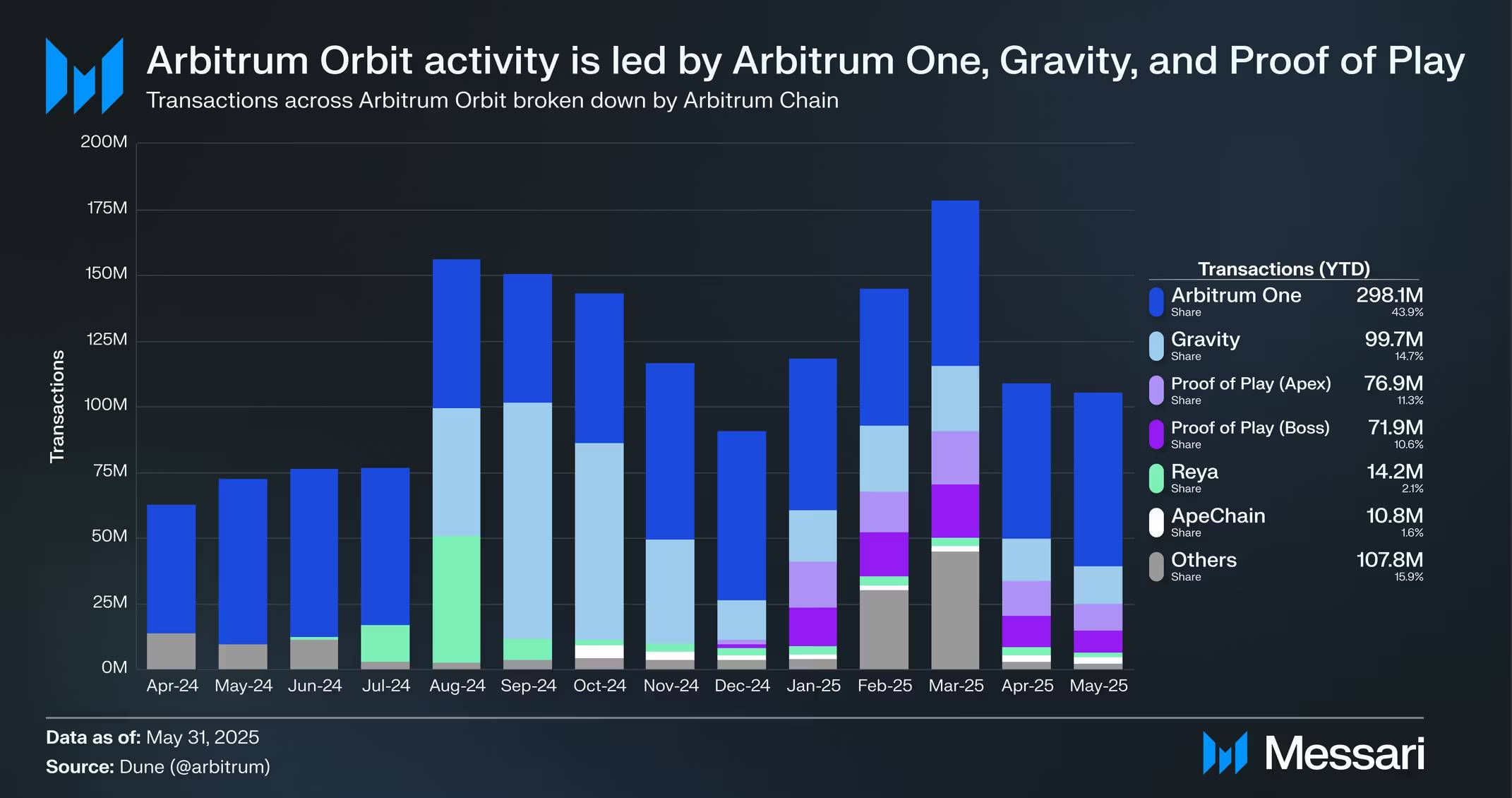
As of May 31, 2025, the monthly average transaction total for 48 publicly announced Arbitrum Chains on the mainnet is 135.8 million transactions. Besides Arbitrum One, the most active Arbitrum Chains include:
Gravity: Gravity was launched by Galxe in August 2024, and is an L2 layer supported by Conduit and the G token. The Gravity ecosystem supports digital identity, community engagement, and on-chain credential verification ecosystem. Gravity was initially launched as part of Arbitrum Orbit and is planned to transition to a high-performance L1 layer in Q4 2025.
- In 2025, the network accounted for 14.7% of Arbitrum Orbit's transaction volume, totaling 99.7 million transactions, with a total locked value (TVL) of $2.7 million. For more information, see Messari's recent report on Gravity.
Proof of Play: Proof of Play is a game studio known for its popular game Pirate Nation, a pirate-themed role-playing game (RPG). Proof of Play has two L3 chains, Apex (launched in March 2024 here) and Boss (launched in August 2024 here), supported by Conduit here. The studio also offers various on-chain services, such as verifiable random numbers and mirroring.
- The network accounted for 21.9% of Arbitrum Orbit's transaction volume in 2025, reaching $148.9 million.
ReyaChain: Reya was launched in April 2024, and is an L2 chain supported by Gelato, offering perpetual futures trading and the rUSD stablecoin. Recently, Reya launched rUSD staking services and plans to release an updated vision for building a decentralized Nasdaq.
- The network accounted for 2.1% of Arbitrum Orbit transactions in 2025, with a TVL of $10.8 million and $16.1 million.
ApeChain: ApeChain was launched in October 2024, and is an L3 chain supported by Caldera and the APE token. ApeChain is the parent company of ApeCoin and Bored Ape Yacht Club (BAYC), focusing on three pillars: content, tools, and distribution. Users can stake assets and earn yields, and utilize applications in gaming and the metaverse.
- In 2025, the network accounted for 1.6% of Arbitrum Orbit's transaction volume, totaling 148.9 million transactions, with a TVL of $10 million. For more information, see Messari's recent report on ApeChain.
Several new Arbitrum Chains that are still evolving will also be launched throughout 2025, including:
Superposition: Superposition was launched in January 2025, and is an L3 platform supported by Conduit, with plans to introduce a centralized limit order book (CLOB). Currently, the first features launched are Super Assets and rewarding users through an automated market maker (AMM).
Edu Chain: Edu Chain was launched by Open Campus in January 2025, and is an L3 supported by Gelato and the EDU token. The network focuses on providing educational services for students and educators worldwide. For a comprehensive overview of Open Campus, see Messari's Initiation of Coverage report.
The growth of Arbitrum Orbit will continue, and here are some Arbitrum Chains that have been officially announced but have not yet launched on the mainnet as of May 31, 2025:
Converge: Converge is a testnet co-built by Ethena and Securitize, which will be an L2 layer aimed at becoming a settlement layer for traditional finance and digital dollars. Converge will implement custom gas tokens like USDe and USDtb, a Converge Validator Network (CVN) backed by sENA, and a Conduit G2 sequencer.
AnimeChain: The testnet AnimeChain, built by Azuki, will be an L3 network powered by the ANIME token. AnimeChain aims to be a network for anime culture, covering fan data, intellectual property (IP), and collectibles.
Huddle01: Huddle01 has been live on the testnet since January 2025, and is an L3 layer designed to support real-time communication (RTC) through a decentralized physical infrastructure network (DePIN). The network will be supported by HUDL, and the second phase testnet launched in April 2025.
CapX: CapX is an L2 protocol that has been live on the testnet since December 2024, aimed at supporting the creation, deployment, and monetization of on-chain AI agents. The protocol includes CapX super applications and CapX cloud services, backed by over $300 million in re-collateralized assets on Symbiotic here. CapX raised $3.1 million in a seed round led by Manifold and Luganodes in March 2025 here.
As numerous Arbitrum Chains prepare to launch on the mainnet, Arbitrum's ability to generate core protocol revenue from block space will continue to strengthen, fueling its growth flywheel.
ArbitrumDAO Governance
ARB is the governance token of ArbitrumDAO, which is responsible for managing protocol upgrades, funding expenditures, and driving the growth flywheel of the Digital Sovereign Nation. Assets in the ArbitrumDAO treasury are typically deployed through ecosystem investment programs such as DRIP, STIP, and LTIP to promote Arbitrum's growth. Economic experimentation areas like STEP and AGV create new revenue streams that, combined with core protocol revenue, drive the flywheel.
ARB token holders can participate in off-chain governance through Snapshot and engage in on-chain governance via Tally, delegating their voting power to themselves or other representatives, some of whom can also earn rewards through the ArbitrumDAO Representative Incentive Program (DIP).
Arbitrum's on-chain governance system allows token holders to make changes to the Arbitrum One and Arbitrum Nova smart contracts, allocate funds, modify the ArbitrumDAO constitution, authorize new Arbitrum Chains (these chains can be deployed without permission, except for L3 chains settled on Arbitrum One), and influence other key aspects of Arbitrum. As of May 31, 2025, ArbitrumDAO has historically proposed 74 on-chain Arbitrum Improvement Proposals (AIP), of which 59 have been approved. Representatives holding at least 1 million ARB can submit two types of AIP:
Constitutional AIP: Proposals to amend the constitution or procedures outlined in AIP-1, modify arbitration parameters, introduce new arbitration chains, or take any actions requiring “chain ownership”.
Approval of a constitutional AIP requires a simple majority vote, with the “yes or abstain” votes needing to reach at least 5% of all votable tokens (as of May 31, 2025, the number of ARB is 220.9 million). However, based on the voting results of the Constitution Quorum Reduction Bill, this percentage will be reduced to 4.5%.
Non-Constitutional AIP: Proposals that do not aim to execute any constitutional AIP actions (e.g., proposals to allocate treasury funds to ecosystem investment programs). Therefore, non-constitutional AIPs do not affect Arbitrum's behavior or technical architecture.
For a non-constitutional AIP to pass, the proposal needs to achieve a simple majority vote, and the “yes or abstain” votes must reach at least 3% of all votable tokens (as of May 31, 2025, this is 132.6 million ARB).
Arbitrum has a security council composed of 12 members, half of whom are elected by ArbitrumDAO every six months. This council is responsible for overseeing Arbitrum's technical risks and primarily makes emergency response decisions to protect the interests of ArbitrumDAO, requiring consensus from 9 of the 12 members.
Arbitrum-aligned Entities
ArbitrumDAO continuously modularizes by introducing entities that collaborate with Arbitrum, which support Arbitrum and act as experts in their respective fields. At the inception of the DAO, most of its work was led by the Arbitrum Foundation. The Arbitrum Foundation has received 750 million ARB (7.5% of the total token supply) as a neutral steward to assist in the implementation of various ArbitrumDAO initiatives, fulfilling its mission to promote ecosystem development, deepen developer education, lead community programs, and support technological advancement.
As Arbitrum gradually evolves into a Digital Sovereign Nation, other entities collaborating with Arbitrum, such as Offchain Labs, Entropy Advisors, and Arbitrum Gaming Ventures, are also providing excellent operational services in their respective fields. The Operation Company (OpCo) is set to fully commence operations, becoming the "operational grid layer" of ArbitrumDAO. OpCo will establish an Oversight and Transparency Committee (OAT) responsible for supervising the entities collaborating with Arbitrum, ensuring they fulfill their respective duties.
On April 4, 2025, Patrick McCorry, A.J. Warner, and Frisson were elected as the first members of the OAT committee, serving as chairpersons. Additionally, the three board members appointed Pedro Breuer and Gavin Wang as the other two members of the OAT committee.
ArbitrumDAO Treasury
The ArbitrumDAO Treasury primarily consists of ARB, with 3.53 billion ARB (35.3% of the total token supply) currently allocated and being used to drive the growth of the Digital Sovereign Nation. Furthermore, ArbitrumDAO is working to diversify its treasury holdings to generate returns through risk-weighted assets (RWA) and DeFi. As of May 31, 2025, the ArbitrumDAO Treasury holds assets valued at $1.21 billion. ARB accounts for 92.7% of the ArbitrumDAO Treasury, ETH for 4%, RWA for 2.3%, and USDC for 1%.
ARB Token

ARB is the ERC-20 equivalent token on Arbitrum One, with a total issuance of 10 billion. The token has been airdropped to early users of Arbitrum to kickstart its decentralization process:
User Airdrop: In March 2023, 1.16 billion ARB (11.6% of the total token supply) was airdropped to user addresses, with the amount received by each address based on their qualifying actions for the airdrop.
Ecosystem Airdrop: In April 2023, 113 million ARB (1.1% of the total token supply) was airdropped to various Arbitrum Orbit projects and Ethereum contributors, with the allocation amount depending on protocol metrics.
The monthly vesting rate for ARB is 10.86 million ARB (1.1% of the total token supply), with full vesting expected by March 2027. However, in March 2025, Offchain Labs announced a strategic purchase plan to strengthen its commitment to Arbitrum, with the company deciding to buy ARB tokens on the open market.
ARB actively fulfills functions related to governance and funding:
Governance: ARB grants token holders the ability to delegate ARB to themselves or other representatives, thereby granting governance rights within ArbitrumDAO and ultimate ownership over the ArbitrumDAO treasury and protocol.
Funding: Stakeholders in Arbitrum typically receive incentives through ecosystem investment programs approved by ArbitrumDAO, contributing to the Arbitrum ecosystem. Additionally, operational projects approved by ArbitrumDAO are also funded by ARB tokens.
Summary
The development trajectory of Arbitrum over the past few years showcases a remarkable evolution. It is no longer defined solely by Arbitrum One but by an ever-expanding ecosystem of Arbitrum Chains driven by a feature-rich technology stack. These technology stacks collectively position Arbitrum as a platform supporting the full lifecycle of developers and users, committed to becoming the largest Digital Sovereign Nation. This vision is not just an aspiration but is being realized through a systematic governance, technology, and incentive mechanism architecture centered around ArbitrumDAO.
Arbitrum's success largely stems from its meticulous improvements to its technological and economic foundations. The Arbitrum technology stack continues to innovate, introducing upgrades such as Stylus, BoLD, and Timeboost, enabling developers to deploy purpose-built Rollup systems. Meanwhile, the ecosystem investment programs and economic opportunity area strategies of ArbitrumDAO have activated a flywheel, creating a self-reinforcing cycle of revenue, investment, and growth.
Arbitrum is omnipresent; it builds not just infrastructure. The ARB token not only governs the protocol but also manages the economic engine. ArbitrumDAO is an increasingly mature entity with a regulatory framework, investment department, and expanding economic influence.
The story of Arbitrum now represents a grander vision: redefining the economy of decentralization and community governance. Arbitrum is poised not only to become a successful ecosystem but also to demonstrate a pioneering stance in on-chain decentralized governance and sustainable value creation.
免责声明:本文章仅代表作者个人观点,不代表本平台的立场和观点。本文章仅供信息分享,不构成对任何人的任何投资建议。用户与作者之间的任何争议,与本平台无关。如网页中刊载的文章或图片涉及侵权,请提供相关的权利证明和身份证明发送邮件到support@aicoin.com,本平台相关工作人员将会进行核查。




